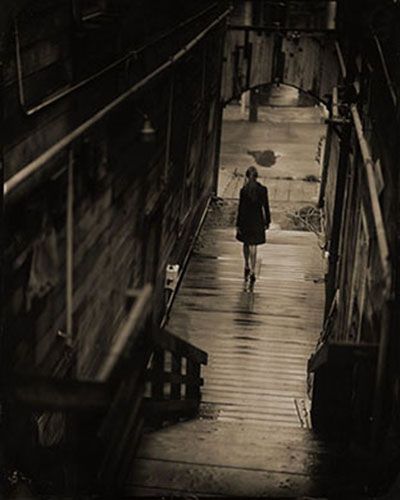
about
PROCESS
I have been working with the platinum / palladium process for at least 15 years. Platinum is a contact printing process. This means If I want a large print , I have to use a large negative . I settled on a 12x20 view camera simply because the size and proportion of that format suited my needs. Up untill about a year ago I've used in- camera negatives exclusively.
I've used a variety of papers, many very different and exotic; one of which is a hand-made japanese paper made from the fibers of the gampi plant. (Sekishu torinoko gampi ) This paper being thin , translucent, and somewhat sticky proved to be extremely difficult to work with. However, because of it's tonal range and unsurpassed beauty, it is well worth the effort.
Recently, I 've ventured into the daunting- world of the wet -plate (collodion ) process ; making images on either trophy aluminum or black glass plates. This beautiful process presently suits my vision , which Includes all of it's edge effects and artifacts. This process creates an original , precious, one-of-a-kind positive. However, no matter how precious, after a one-of-a-kind image is sold it's gone. This necessitated a desire to duplicate the original wet-plate image. I wanted to be able to make prints combining both techniques; the platinum printing technique for it's choice of papers and beautiful color, with the esthetics of wet-plate collodion
Consequently, I scan the wet-plate positive using an Epson 10,000 XL. Then using Photoshop, I manipulate the image for my taste, to create a digital negative to be printed on hand-coated platinum/palladium paper. This is a circuitous route from 1850's wet-plate back to 1876, when the platinum process originated. This also allows the advantage of using smaller view cameras, which enables access to areas that can be somewhat prohibitive with the larger equipment.
I've also started making Inkjet prints, (something I thought I'd never do ), since I've always considered myself an alternative - process- type guy. Inkjet prints have definitely come a long way; they are quite beautiful and also alot of fun ; not to mention the freedom and versatility they afford by allowing a multiple of creativ e variations.
This combination of tools, used for blending venerable old processes with the new, ultimately allows me a very wide range of options. I've just begun to explore the many different alternatives I can now choose. This is surely a wonderful time to be a photographer.
p.s. more will be revealed.
